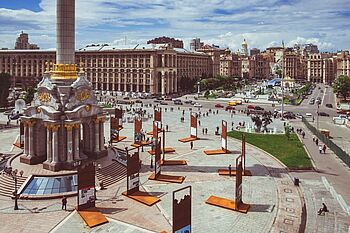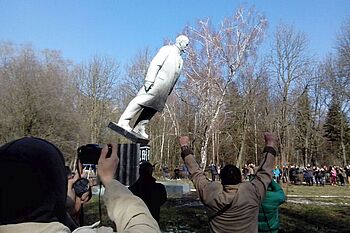Visitors examining materials on display at the Holodomor Museum in Kiev. Unlike other post-Communist countries, a reckoning with Ukraine’s dictatorial past took place rather late – but once it began, it used radical instruments. Experts on Eastern Europe have accompanied this process and offered a critical analysis.
Lustration in Ukraine

Credit: Euan Cameron / unsplash
Maidan Nezalezhnosti - Independence Square in Kiev is the most famous square in Ukraine. In 2004, hundreds of thousands of Ukrainians gathered here for the “Orange Revolution.” Ten years later, the square again became the scene of protests when the “Euromaidan” movement forced a profound political change. In 2016, political scientist Evgenija Lezina evaluated how successful the demonstrators were in achieving their demand for fundamental change within the political elite.
Unlike most countries of the Eastern Bloc, Ukraine was not a nation-state in its own right until 1991. It had not even had its own national Communist Party because it joined the Russian one soon after its founding. “Ukraine’s long existence in the Russian empire and in the Soviet Union gave rise to a mixed society,” the author writes at the beginning of her analysis. This is why it was more deeply permeated by elites and why totalitarian practices between state and society were more intensively implemented. Even after independence, many Communist and Russian functionaries retained their positions of power, for example in the Ukrainian secret service, the SBU.
No serious efforts to decommunize were made until after the Orange Revolution and these were essentially limited to the state’s commemorative policy. This remained the case until after the “Euromaidan” in 2014, when President Viktor Yanukovych, the “protégé of the ex-Soviet nomenklatura and the Kremlin,” fled. The demand now focused on lustration – a review of officials and top functionaries with the aim of replacing incriminated cadres. Another factor was the belief that the losses in the war with the separatists in the Donbass were caused by Russian infiltration of Ukrainian military structures.
In October 2014 – more than two decades after Ukrainian independence – the parliament passed the law “On purging the government apparatus.” The law, which was essentially drafted by activists of the “Euromaidan,” had several tasks: First, the removal of former cadres of the CPSU and former employees of the Soviet secret services from the state apparatus. Second, the dismissal of top officials who had held posts under Yanukovych for at least one year and had not resigned. Third, investigating officials’ incomes and assets in search of rampant corruption. Fourth, establishing a special law “On restoring confidence in the judiciary,” which called for the dismissal of all judges who had handed down sentences against participants in the Euromaidan protests.
The mandatory reviews were to be conducted on a decentralized basis and the results sent to the Ministry of Justice, which kept a list of all lustrated officials. A 12-member Council for Lustration Issues was to ensure that the reviews be handled properly. This was necessary because, according to the author, the institutions concerned almost invariably sabotaged the procedure. Opponents of the law also turned to the Constitutional Court, which was itself affected by the lustration and therefore biased. The Venice Commission of the Council of Europe also took an interest in the law and, in an initial statement, demanded proof of personal guilt on the part of those lustrated.
Despite these obstacles, 300,000 officials were vetted in Ukraine over the course of two years. Of the 5,000 officials who had held high offices under Yanukovych, 936 were dismissed. Thousands more vacated their posts voluntarily. Only in five percent of the cases were people dismissed because of their activities under the Communist dictatorship. In 15 percent, asset verification was the decisive factor. The remaining 80 percent were former Yanukovych officials. Only 58 people from the SBU secret service were dismissed, but 3300 employees left of their own accord.
Judges posed the greatest difficulty, which is why, although 29 were designated for dismissal, most were able to successfully file a suit against the decision at the Supreme Administrative Court. For this reason, in September 2016, another law came into force: “On the judiciary and status of judges.” It required all judges to be selected by an independent group of experts and to disclose their financial circumstances. After this law was passed, more than 1,000 judges resigned voluntarily.
The author concludes that in Ukraine most of the incriminated cadres were in fact dismissed from their leadership positions or left of their own accord. From this perspective, the lustration was indeed successful. The fight against corruption in the state apparatus, on the other hand, was a failure.
To read the entire text by Evgenija Lezina, click here.
Links
Crime researcher Yuliya Zabyelina on the distinctiveness of lustration in Ukraine
Master’s thesis by Galyna Saltan on the unsuccessful transitional justice in Ukraine
After the Dictatorship. Instruments of Transitional Justice in Former Authoritarian Systems – An International Comparison
A project at the Department of Modern History at the University of Würzburg
Twitter: @afterdictatorship
Instagram: After the dictatorship
With financial support from the German Federal Ministry for Economic Cooperation and Development
From Lenin to Lennon

Credit: Volodymyr D-k / CC BY-SA 3.0
On February 21, 2014, the Soviet dictator Vladimir Ilyich Lenin was toppled – not the actual person, but his effigy, which stood in the recreational park of the industrial city of Khmelnytskyj. In several waves since independence, more than 5000 Lenin monuments were removed in Ukraine. In 2015, a law required not only the removal of Communist symbols but also the renaming of Soviet street names. Political scientist Maksym Y. Kovalov has studied this process of decommunization.
The author begins his analysis by noting that while strolling along Lennon Street in Kalyny, one might wonder why John Lennon and the Beatles are honored here so prominently. The reason, he says, lies solely in the name’s similarity to the founder of the USSR, after whom, like everywhere in the Soviet Union, the city’s central street was named. Lenin became Lennon – which sounded the same to the inhabitants.
After Ukraine achieved independence, there was no decommunization process to speak of at the national level. A single law on the rehabilitation of the victims of Stalinism and the Gulag was passed in 1991. Only after the Orange Revolution were several measures taken regarding remembrance policy, including the establishment of the Ukrainian Institute of National Remembrance. In the late 2000s, however, most of Ukraine’s main streets still contained the words “Lenin,” “Soviet,” or “October” in their names.
In April 2015, the Ukrainian parliament – the Rada – passed four decommunization laws. The first law honored the organizations that had fought for an independent Ukraine and been vilified in the Soviet Union as Nazi collaborators. The second law opened the archives of the Communist era to the public. The third law rejected the Soviet interpretation of history which suggested that World War II had begun in 1941, thereby dismissing the two-year cooperation between Hitler and Stalin. The fourth law banned the use of Soviet and Nazi symbols in public spaces. It also demanded that cities, government districts (oblasts), streets and squares be renamed and that monuments, memorial plaques and other symbols of the Communist era be removed.
The local self-governing bodies had six months to rename the streets. If they did not comply, the mayors were to mandate the renaming and the deadline would be extended another three months. If they still failed to act, the new names were to be prescribed by the heads of the territorial administration by May 21, 2016. This led most regions to establish commissions made up of historians and local specialists. They drew up lists of Soviet-era street names, discussed them with local residents, and proposed new names to city councils. The Institute of National Remembrance provided guidelines for this and a list of over 500 people who should no longer be honored.
In his study, the author examines which municipalities supported this type of decommunization and which did not. He bases this judgement on whether or not the city councils met the deadline. He concludes that – contrary to popular belief – it was not the historical East-West divide in the country that was decisive, but rather the “politics of the present”: whether streets were renamed on time depended not on the region, but on the activities of the renaming commissions and the number of local political opponents. “The passive or confrontational work of toponymic commissions, combined with a higher number of subnational veto players, generally explains resistance to street renaming,” he writes. He notes that in contrast, when there was a strong “commission effort,” the renaming process went smoothly.
As an example, he cites the city of Vinnytsia, where the commission and civil society groups conducted a lively information campaign with a series of 65 posters, titled “Street Duel,” in which the names of old and new streets were juxtaposed. Another project produced 44 soundtracks for public transport that announced the new names at bus stops and explained their meaning. The campaign included signs presenting the new names at the station stops. The author concludes that “political rather than structural factors” were decisive in the process of decommunization.
In the last section, the author also addresses the present situation. The Russian invasion of Ukraine in February 2022 triggered a new wave of street renaming and monument removal. In April 2022, for example, the authorities in Kiev got rid of a monument that symbolized friendship between Russia and Ukraine. Some 467 other street names were targeted for renaming, including those commemorating Russian poets, writers, and musicians. Decommunization had basically turned into derussification.
The entire text is found here (restricted access).
Links
Historian John-Paul Himka on the decommunization laws of Ukraine (restricted access)
Website of the Ukrainian Institute of National Remembrance (Ukrainian)
Political Scientist Oxana Shevel on the Battle for Historical Memory in Ukraine (restricted access)
Resolutions of Verkhovna Rada on the renaming of Ukrainian localities